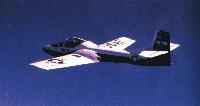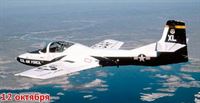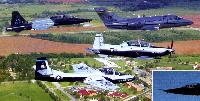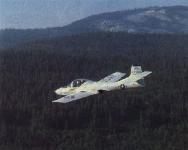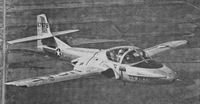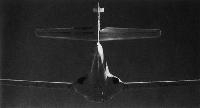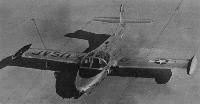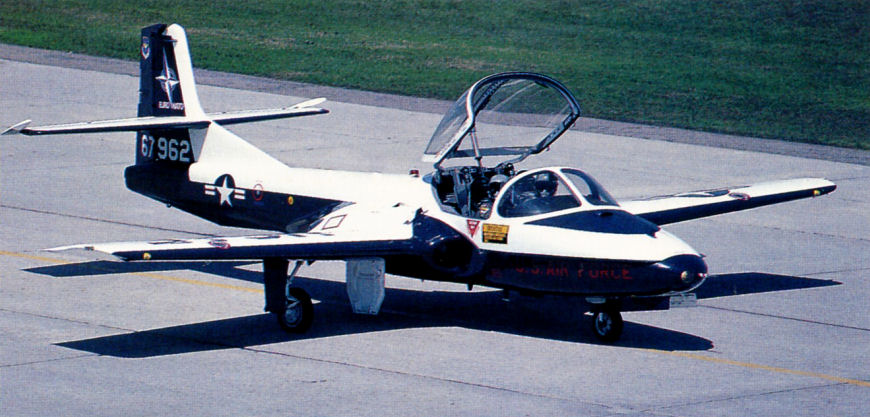
Описание
Страна : США
Год : 1954
Двухместный учебно-тренировочный самолет для первоначальной летной подготовки
Варианты
- Cessna - T-37 Tweety Bird - 1954 - США
- Cessna - A-37 Dragonfly - 1967 - США
Cessna Model 318 (T-37 "Tweet")
Самолет Model 318 разработали в 1952 году в ответ на выпущенную ВВС США спецификацию на реактивный учебный самолет для начальной подготовки. Сначала были заказаны два прототипа XT-37. Первый из них взлетел 12 октября 1954 года с двумя турбореактивными двигателями Continental YJ69-T-9 тягой по 4,18 кН (лицензионный Turbomeca Marbore), установленными в корневых частях прямого крыла. Под общим фонарем кабины стояли бок о бок сиденья экипажа. Конфигурация в целом была обычной, стабилизатор приподнят на 1/3 высоты киля. Ручное управление оснащалось триммерами с электроприводом, в то время как закрылки и шасси с широкой колеей приводились в действие гидравликой.
За начальной партией из 10 самолетов T-37A (Model 318A) последовали 524 в целом схожих с ними машин с двигателями J69-T-9. Первый из этих самолетов взлетел 27 сентября 1955 года, но поступление на службу отложили до 1957-го из-за необходимости внесения изменений и доработок.
В 1959 году серийно начали выпускать версию T-37B (Model 318B) с двумя турбореактивными двигателями J69-T-25, улучшенными системами навигации и связи, а также с возможностью подвески топливных баков на законцовках крыла. Всего собрали 466 таких самолетов, несколько из них поставили на экспорт. 47 машин получили ВВС ФРГ, но они остались в США, куда прибывали для обучения немецкие пилоты. Все оставшиеся T-37A модифицировали до стандарта T-37B. С апреля 1961 года планировался перевод ВВС США на "сквозное" обучение на реактивных самолетах T-37, но из-за высокой стоимости в 1965 году пришлось снова вводить 30-часовой этап первоначального обучения на поршневых машинах Cessna T-41A. Впоследствии ненадолго было снова введено обучение сразу на реактивных УТС, но сегодня пилоты вновь проходят первоначальный этап обучения и отбор на самолетах с поршневыми моторами.
T-37 должны были заменить на новый УТС Fairchild T-46A, но разработку этой машины отменили в 1986 году. Предложенная модификация T-37 под названием T-48 не нашла поддержки, и с 1989 года компания "Sabreliner Corporation" начала поставлять ВВС США комплекты новой оснастки для модификации T-37 и восстановления их конструктивной прочности для продления ресурса. В конечном счете, с 2001 года самолеты T-37 заменили на УТС Raytheon T-6A Texan II. Последний в ВВС США учебный полет на T-37 состоялся 31 марта 2008 года.
Последняя версия машины Tweet, как прозвали T-37 в американских ВВС, никогда не применялась в США. Вариант T-37C строили на экспорт для программ военной помощи и сбыта военной техники за рубежом. Были собраны 269 легких ударных самолетов с облегченной подвеской, пушечным прицелом K-14C и двумя подкрыльевыми пилонами, способными нести боевую нагрузку массой до 113 кг, включая контейнер General Electric с 12,7-мм пулеметом. В фюзеляже мог монтироваться АФА. T-37C поставлялись в Бирму, Португалию (30 машин), Турцию, Чили, Грецию, Перу, Таиланд, Колумбию (получившую также лишние самолеты T-37B из ВВС США) и Пакистан (также получивший по договору от августа 2008 года машины T-37B, подкрепленные партией самолетов из запасов ВВС США взамен списанных).
ТАКТИКО-ТЕХНИЧЕСКИЕ ХАРАКТЕРИСТИКИ
Cessna T-37B
Тип: двухместный учебно-тренировочный самолет для первоначальной летной подготовки
Силовая установка: два турбореактивных двигателя Teledyne Continental J69-T-25 тягой no 4,56 кН
Летные характеристики: макс, скорость 684 км/ч на высоте 7620 м; крейсерская скорость 612 км/ч на высоте 7620 м; начальная скороподъемность 1037 м/мин; практический потолок 11950 м; радиус действия 1500 км
Масса: пустого самолета 1755 кг; максимальная взлетная 2993 кг
Размеры: размах крыла 10,30 м; длина 8,92 м; высота 2,80 м; площадь крыла 17,09 м2
- Описание
Фотографии
-
Мировая Авиация 177
Принадлежавшие ВВС США самолеты T-37 большую часть своей службы провели в естественной металлической окраске, но иногда использовался и черно-белый вариант окраски.
-
Мировая Авиация 177
Cessna T-37B чилийских ВВС. Последние эксплуатировали T-37 в период 1963-1988 годов в качестве учебных и легких штурмовиков. Сегодня эти задачи решают ENAER T-36 Halcon.
-
Мировая Авиация 88
Свыше четырех десятилетий службы показали, что учебно-тренировочный самолет T-37 оказался надежной машиной. Однако срок его эксплуатации подошел к концу даже для изображенной на снимке версии T-37B.
-
Мировая Авиация 177
T-37 почти 40 лет был основным учебным самолетом ВВС США. Вначале T-37 предполагали заменить на Fairchild T-46A, но в 1987 году это решение отменили, а в качестве замены выбрали Raytheon T-6A Texan II, приобретаемый по совместной с ВМС США программе.
-
Изд-во Schiffer / S.Markman & B.Holder - One-of-a-kind research aircraft
A T-37, such as the one shown here, served as a prototype for several different attack versions of this aircraft.
-
Авиация и Время 2017-02 / П.Нор - Реактивные учебно-тренировочные самолеты
Американский учебно-тренировочный самолет 1-го поколения T-37
-
Мировая Авиация 247
Представлены самолеты, которые использовались на авиабазе Вэнс (кодировка "VN") в 2005 году для учебно-тренировочных полетов. На заднем плане - T-38 из 25-й учебно-тренировочной эскадрильи, перед ним - T-1A Jayhawk из 32-й учебно-тренировочной эскадрильи, далее - T-6A Texan II из 8-й эскадрильи и T-37B Tweet из 33-й эскадрильи. T-37 сняты с вооружения ВВС США в 2009 году.
Другие самолёты на фотографии: Beechcraft Model 400 Beechjet / T-1 Jayhawk - США - 1986Beechcraft T-6A Texan II - США - 1995Northrop T-38 Talon - США - 1959
-
Мировая Авиация 177
Самолет T-37B-CE (66-7978) - типичный серийный "Tweety Bird", поставлявшийся Учебному авиационному командованию ВВС США. Построено 552 самолета T-37B - он стал самым многочисленным вариантом Model 318. На T-37 стояли двигатели Continental/Teledyne J69 - лицензионный вариант ТРД Turbomeca Marbore, установленного на Magister. На T-37B вместо J69-T-9 установили более мощный двигатель J69-T-25 - тягой 4,61 кН вместо 4,14 кН.
-
Air International 1984-08 / T.Cleaver - "Tweety Bird"
The standard take-off formation for a pair of T-37Bs has their wing tips only three feet (1 m) apart. The base below, inhabited by SAC B-52s. is Mather, Sacramento
-
Air International 1984-08 / T.Cleaver - "Tweety Bird"
The "Tweety Birds" play tag over the forests of the Sierra.
-
Air International 1984-08 / T.Cleaver - "Tweety Bird"
Seen here on the flight line, the Cessna T-37B has been the USAF's standard basic trainer since 1958. It is to be replaced before the end of the decade by the Fairchild T-46A, the so-called New Generation Trainer.
-
Air International 1981-04 / J.Fricker - Problems for Pakistan's Air Power
Cessna T-37Bs of the PAF Academy at Risalpur, used for basic training following an initial 44 hours on the Mushshak.
-
Air International 2012-04 / News
The Basic Flying Training Wing at Risalpur, home to the Pakistan Air Force Academy, is currently taking delivery of 40 ex-US Air Force Cessna T-37Bs. Though only some of them will be put into service, these additional Tweets will enable the air force to ramp up its pilot training.
-
Мировая Авиация 177
T-37B пакистанской Авиационной академии несет яркую окраску. Вслед за T-37C (первый поставлен в 1962 году) последовали T-37B, списанные ВВС США в начале 1980-х годов. Будущие пакистанские пилоты после подготовки на самолетах MFI-17 Mushshak должны были налетать 720 часов на T-37 и лишь затем - пересесть на K-8. T-37 входили в состав 1-й и 2-й учебных эскадрилий базовой подготовки, дислоцированных в Рисалпуре.
-
Air International 2008-07 / D.Willis - Military Display Teams /Military/ (2)
Since its formation in 1972 the Pakistan Air Force Sherdil's J-37s have worn several different colour schemes. They were initially red overall; then natural metal with a DayGlo orange nose, wingtips and tail; in 1980 they received a sunburst scheme; and now have a striking red, white and blue finish.
-
Air International 1981-09 / ??? - Hellenic Air Power ... a continuing NATO asset?
The Cessna T-37 has been used by the HAF for basic flying instruction for the past 16 years, attrition suffered by those delivered to Greece in the mid- 'sixties having been made up last year by the transfer of four aircraft from USAF stocks.
-
Air Pictorial 1992-01 / P.Foster - Elliniki Aeroporia Nato's not so soft underbelly
T.37C 12802 with hard points seen landing at Kalamata in silver and red colour scheme. This is now giving way to white and red scheme to help prevent corrosion.
-
Air International 1987-11 / P.Jackson - Royal Jordanian Air Force: Air Power at Three-continent Crossroads
The pilot training syllabus includes 110 hrs on the Cessna T-37Bs of No 11 Squadron. Earlier aircraft were in natural metal finish, those that came later bearing the USAF training white overall.
-
Air Enthusiast 1998-05 / R.Niccoli - Portuguese Numerology
Displayed at Sintra, near the main gate, is T-37C 2424 in the colours of the national aerobatic team, Asas da Portugal.
-
Мировая Авиация 177
Прототип Cessna Model 318 (XT-37) поднялся в воздух в аэропорту Уичиты, штат Канзас, 12 октября 1954 года. Он был оснащен ТРД Turbomeca Marbore, который собирался по лицензии в США как J69 компанией "Continental".
-
Air Pictorial 1956-04
Switching from tandem to side-by-side seating, the U.S.A.F. has, with the twin-jet Cessna T-37A, the first of a new series of intermediate jet trainers. The Cessna Model 318 has a maximum speed in excess of 400 m.p.h. and an a.u.w. of 5.600 lb. The photograph shows clearly the lightweight ejection seats and the root intake to the starboard 920-lb. s.t. Continental J69-T-15 (licence-built French Turbomeca Marbore II). Rubber de-icing boots on the in take are new, as are the revised aileron and flap shapes. Most noticeable changes from the prototype (U.S.A.F. 54-716) are the additional "keel" bumper and the larger fin and rudder, which are now more square-cut. The forward fin fairing is now straight-edged and of increased area. The dark (red) band immediately behind the canopy indicates the separation point for rear fuselage removal during overhauls. The T-37A is in production at Wichita, Kansas. Fifteen pre-production models are now entering service. Span 33 ft.; length 27 ft. 1 in.; initial rate of climb 3,000 ft.p .m.; range 935 miles; cruising speed 310 m.p.h. (N.B.: Sharp eyes may detect the shadow of a swept-wing fighter which has attracted the attention of the pilot. Look for the shadow under the nose of the T-37A, almost under the "AIR" of U.S. Air Force.
-
Jane's All the World Aircraft 1972 / 01 - Aircraft
Cessna T-37B two-seat primary jet trainer (two 1,025 lb st Continental J69-T-25 turbojet engines)
-
Air International 1984-08 / T.Cleaver - "Tweety Bird"
The author's T-37B flies close formation for a barrel roll at 18.000ft (5486 m).
-
Мировая Авиация 177
T-37 имел элегантную конструкцию, хотя фюзеляж был слишком широким - инструктор и курсант сидели плечом к плечу. Обратите внимание на расположение двигателей Continental J69 - в корне крыла, что было скопировано с учебного самолета Fouga Magister, имевшего оригинальные французские двигатели Turbomeca Marbore.
The Cessna T-37 jet trainer. The former has been used for training the pilots of thirty-four different countries, and it is still in service today. The T-37 is just entering service as a primary trainer and features side-by-side seating. Note the added "chines" on each side of the nose. -
Air International 1984-08 / T.Cleaver - "Tweety Bird"
The author's T-37B comes up close in the six o 'clock position on the lead Cessna.
-
Air International 1984-08 / T.Cleaver - "Tweety Bird"
Gear down, the T-37B begins its approach to Mather AFB. The landing gear can be extended at any speed and is regularly used as a speed brake.
-
Jane's All the World Aircraft 1964 / 01 - Aircraft
Регистрационный номер: N5427E Cessna T-37B with two General Electric general-purpose armament pods
-
Jane's All the World Aircraft 1976 / 01 - Aircraft
Cessna T-37C two-seat primary jet trainer with armament provisions
-
Air International 1992-10 / Talkback
‘Forca Aerea Portuguesa’ Cessna T-37C of Esc 102 ‘Base Aerea 1’ at Sintra. The type has now been withdrawn from FAP service and a replacement has yet to be ordered.
-
Air Enthusiast 1998-01 / R.Niccoli - Atlantic Sentinels
In January 1963 the FAP received the first 12 Cessna T-37s, assigned to the flight school at BAI Sintra.
-
Jane's All the World Aircraft 1980 / Encyclopedia of Aviation - 3. World Directory of Air Forces
Portuguese Air Force Cessna T-37.
-
Air Pictorial 1977-08 / J.Rawlings - Greenham Commons
The Portuguese Cessna T-37Cs with R.A.F. No. 11 Squadron Lightnings beyond and Jaguars, Super Mysteres, Starfighters, etc. opposite
-
Air Pictorial 1977-08 / J.Rawlings - Greenham Commons
Cessna T-37Cs of the Portuguese A.F.'s vivacious new aerobatic team
-
Aeroplane Monthly 1990-01 / Camera competition winners
Third prize goes to Toine Strooij of Rotterdam, The Netherlands, for his photograph of the Cessna T-37s of the Asas de Portugal, also taken at the International Air Tattoo at Fairford on July 22, 1989. Toine wins a Canon Sureshot Ace compact camera, worth £129.
-
Jane's All the World Aircraft 1966 / 02 - Aircraft
Cessna T-37C basic jet trainer of the Peruvian Air Force
-
Air International 1981-04 / J.Fricker - Problems for Pakistan's Air Power
Cessna T-37Bs of the PAF Academy at Risalpur, used for basic training following an initial 44 hours on the Mushshak.
-
Air International 1984-02 / S.Huertas - The Chilean Air Force ... an air arm with a problem
The Beechcraft Mentor - Cessna T-37C (on photo) flying training syllabus at the Escuela de Aviacion at El Bosque is now giving place to a T-35 Pillan - T-36 Halcon syllabus and a full complement of the latter trainers will be attained this year.
-
Air Pictorial 1957-11
The Cessna T-37A is the standard two-seat primary trainer of the U.S.A.F. and will replace the present piston-engined T-34A Mentor. Flown for the first time on 12th October 1954, the T-37 was originally intended as an intermediate trainer between primary training on piston-engined aircraft and advanced training on a high-speed jet aircraft. Since then Air Force requirements have changed and the piston-engined aircraft phase has been dropped and an all-jet training scheme adopted. The T-37 features side-by-side seating for the instructor and pupil and is unusual in U.S. trainers in this respect. Of all-metal construction its wing incorporates high-lift slotted flaps, and an air brake is situated just aft of the nosewheel doors. Equipment includes provision for day and night instrument flying, jettisonable canopy and ejector seats. Engine inlet screens extend automatically over the wing-root air intakes when the undercarriage is locked in the down position, and they prevent stones or other debris entering the intake ducts during take-off and landings. The screens retract with the undercarriage. Power plant is two 920-lb.s.t. Continental J69-T-9 turbojets and they give the T-37 a maximum speed at 35,000 ft. of 393 m.p.h. Since the prototype was first flown the aircraft has been modified with the addition of a rear underfuselage strake, and a nose strake, one either side, which was fitted to increase fuselage damping and reduce spin rate.
- Фотографии




